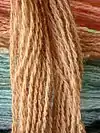Disperse dye
Disperse dye is a category of synthetic dye intended for polyester and related hydrophobic fibers. Disperse dyes are polar molecules containing anthraquinone or azo groups. It is estimated that 85% of disperse dyes are azos or anthraquinone dyes.[1][2]
History
The history of disperse dye production is closely related to the synthesis of cellulose acetate fibres. Disperse dyes were invented in 1923-24.[3]
Fundamentals of dyeing
Disperse dyes are non-ionic in nature and partially soluble in water. The interaction of dye molecule and polymer takes place with Van der Waals and dipole forces.[4] Disperse dyes have better diffusion at boiling to a higher temperature.[5]
Examples
- Disperse Orange 1 is an azo dye.
- Disperse Red 9 is a red dye derived from anthraquinone.
- Disperse Red 11, also called C.I. 62015 and 1,4-diamino-2-methoxy anthraquinone, is another anthraquinone dye.
- Disperse Red 60 is also an anthraquinone dye.
- Disperse Yellow 26 is a yellow disperse dye.
- Disperse Yellow 42 is prepared by the reaction of two equivalents of aniline with 4-chloro-3-nitrobenzenesulfonyl chloride.
References
- "Dyeing Polyester with Disperse Dye".
- Hamprecht, Rainer; Westerkamp, Aloys (2000). "Disperse Dyes". Ullmann's Encyclopedia of Industrial Chemistry. Weinheim: Wiley-VCH. doi:10.1002/14356007.a08_565.
- Clark, M. (2011-10-25). Handbook of Textile and Industrial Dyeing: Principles, Processes and Types of Dyes. Elsevier. p. 366. ISBN 978-0-85709-397-4.
- "Disperse Dye - an overview | ScienceDirect Topics". www.sciencedirect.com. Retrieved 2020-12-28.
- Lewin, Menachem; Pearce, Eli M. (1998-02-26). Handbook of Fiber Chemistry, Second Edition, Revised and Expanded. CRC Press. p. 53. ISBN 978-0-8247-9471-2.
This article is issued from Wikipedia. The text is licensed under Creative Commons - Attribution - Sharealike. Additional terms may apply for the media files.
